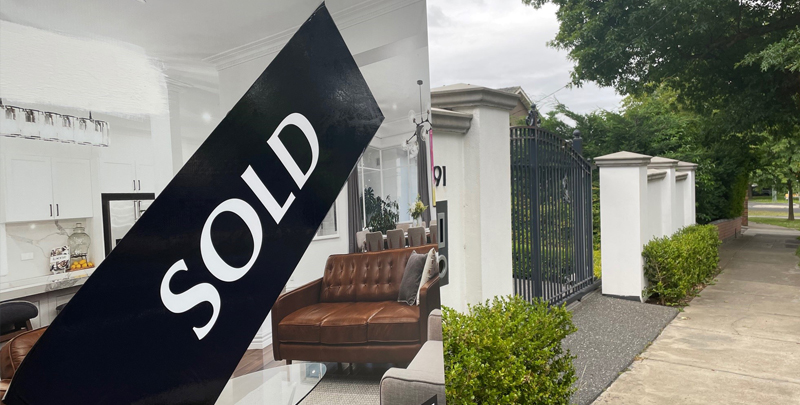Experience tells us that strong outcomes in residential property don’t come from shortcuts.
You might have a loyal renter keen to buy, a well-held home in a prime suburb, and the urge to skip ahead to a quick, painless deal. But this case-study of a home in St Kilda illustrates exactly why sellers are best served by rigorous planning, managed contingencies, and the discipline never to rely on a single scenario.
Here’s how one carefully executed dual campaign protected value – and, when the ‘obvious’ sale fell over, unlocked a strong alternative result.
A long ownership, an eager renter
Our client’s two-storey 1930s house in St Kilda had seen just three renters over 25 years – a testament to its location and liveability.
The most recent renter, settled for nearly a decade, felt so at home they were keen to buy as soon as the owner decided to sell.
For many vendors, this feels like a win: willing buyer, no open homes, limited marketing costs.
But beneath the surface, reality is rarely so reliable.
Running a dual plan for surety and alternative opportunities
Having personally seen too many of these types of deals fall through, we put a dual plan in motion from day one:
- Engaging seriously with the renter, setting clear expectations about timelines and unconditional terms, but sticking to a disciplined process.
- Mapping out (and quoting for) a full suite of necessary upgrades – internal and external paint, fresh floorboards, new carpet, a series of handyman repairs and, crucially, a dramatic garden revival.
- Issuing notice to vacate in parallel, establishing tight but realistic timeframes for either buyer to proceed or the campaign to go live.
- Organising trades and styling in advance, so work could begin the moment the property was empty.
The aim? If the renter could proceed quickly with an unconditional offer, brilliant. If not, there would be no delay or lost opportunity in preparing a market-facing sale.
First hurdle: The limit of the renter-sale
Initial conversations with the renter were positive – they loved the home and, in early talks, hinted at figures above what we were expecting.
But soon the practical limitations became evident. The renter did not have finance in place, needed to sell an investment property, and struggled to commit to the unconditional deal required within our fixed deadline, and then reduced their offer.
When faced with those requirements, reality set in, and the renter candidly withdrew, recognising they couldn’t move as quickly or with as much certainty as needed.
After nearly a decade, the renter had carried out various DIY improvements, some with approval, some on their own initiative. When it came time to vacate, the renter wanted to take some of these improvements with them.
This needed to be dealt with politely and decisively. We explained they were welcome to remove any items they’d installed themselves, but any changes would need to be fully restored to their original (or better) condition.
Once the requirements were clear, thankfully the renter chose to leave the improvements as they were.
With the owner now leaving on relatively good terms, our dual strategy paid dividends as we were already active, and the campaign never lost momentum.
Seamless transition: Repairs & refurbishment without delay
With notice to vacate already in hand and trades ready, the day the property was empty, work commenced on schedule. Every element had been considered:
- Paintwork: Inside and out, including the rendered exterior, for a fresh look and improved street appeal.
- Floors & Carpets: Boards polished and carpets replaced, renewing quality and removing signs of age.
- Repairs: All those telling handyman details dealt with – realigning cupboard doors, fixing grouting, addressing minor but revealing defects.
- Garden: Major clean-up and replanting, transforming outdoor spaces – a standout in St Kilda.
- Styling: Once the works were finished, professional styling revealed the home’s potential, ready for photography and buyer inspections.
Preparations took roughly four weeks – every day planned, every spend weighed against the likely return.
Market launch and auction
In a relatively flat Melbourne market at the time, the campaign drew steady, but not spectacular, inspection numbers.
The buyers, though, were qualified and the right fit for the property. The agents reported good engagement, but no frenzied competition.
On auction day, only one genuine bid came in – just above the bottom end of the quoted range.
For many, that could prompt disappointment.
But our strategy was set: pass the property in, regroup, and use post-auction processes to build momentum.
Post-auction: Preparation breeds opportunity
This is where best practice truly counts.
As soon as public auction pressure lifted, two parties who’d previously said the home “wasn’t right” returned for further inspections and negotiations.
Another buyer, seeing the house for the first time on auction day, joined the mix.
Over just two days, three parties made serious offers.
Negotiations intensified, building inspections arranged, and by Tuesday afternoon, an unconditional offer came through – $25,000 above our original upper range, with a short settlement and no conditions attached.
The owner, understandably, was delighted.
Simplicity can’t always be relied on
Had we assumed a direct sale to the renter was a done deal and delayed proper preparations, our client would have missed out on both opportunity and value.
The dual plan protected against hesitation and risk, giving the renter every chance while ensuring the property reached its full potential on the open market.
Take home message
The property market rarely rewards wishful thinking. Even the most promising shortcut can come unstuck.
Real success comes from treating every sale with discipline: plan for the best, prepare for the worst, and keep your options genuinely open.
When circumstances change – as they almost always can – preparation and sound strategy is what creates and delivers on opportunity.
Listen to Jarrod’s podcast:

